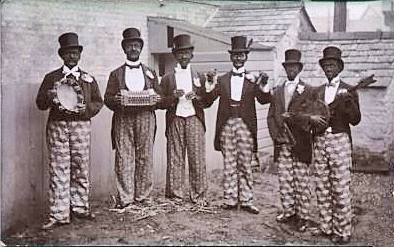Annotation:Jim Crow: Difference between revisions
No edit summary |
m (Text replacement - "garamond, serif" to "sans-serif") |
||
| Line 1: | Line 1: | ||
=='''Back to [[{{BASEPAGENAME}}]]'''== | =='''Back to [[{{BASEPAGENAME}}]]'''== | ||
---- | ---- | ||
<p><font face=" | <p><font face="sans-serif" size="4"> | ||
'''JIM CROW'''. AKA - "[[Jump Jim Crow]]." Old-Time, Breakdown and Song Tune. D Major. Standard tuning (fiddle). ABC. A song popularized on the minstrel stage of the mid-19th century. "Jim Crow" (and "Jim Crow Polka") were printed in the earliest surviving collection of minstrel music, '''The Complete Preceptor for the Banjo''' (1848), by 'Gumbo Chaff', a pseudonym for Boston publisher Elias Howe. Howe sold the rights to the collection and others of his works to another Boston publisher, Oliver Dixon (who issued the Chaff tutor in 1851) on the condition that Howe refrain from publishing similar works for ten years. Dave Evans remarks on the similarity of the title "Jim Crow" to "John Crow," a folk name for a buzzard, and suggests that the "Jim Crow" song and dance is perhaps derived from the slave dance "The Buzzard Lope" (see Parish, '''Slave Songs of the Georgia Sea Islands''', 1942). See also "[[Annotation:Jump Jim Crow]]." | '''JIM CROW'''. AKA - "[[Jump Jim Crow]]." Old-Time, Breakdown and Song Tune. D Major. Standard tuning (fiddle). ABC. A song popularized on the minstrel stage of the mid-19th century. "Jim Crow" (and "Jim Crow Polka") were printed in the earliest surviving collection of minstrel music, '''The Complete Preceptor for the Banjo''' (1848), by 'Gumbo Chaff', a pseudonym for Boston publisher Elias Howe. Howe sold the rights to the collection and others of his works to another Boston publisher, Oliver Dixon (who issued the Chaff tutor in 1851) on the condition that Howe refrain from publishing similar works for ten years. Dave Evans remarks on the similarity of the title "Jim Crow" to "John Crow," a folk name for a buzzard, and suggests that the "Jim Crow" song and dance is perhaps derived from the slave dance "The Buzzard Lope" (see Parish, '''Slave Songs of the Georgia Sea Islands''', 1942). See also "[[Annotation:Jump Jim Crow]]." | ||
[[File:blackface.png|500px|thumb|left|Blackface minstrel troupe, c. 1875]] | [[File:blackface.png|500px|thumb|left|Blackface minstrel troupe, c. 1875]] | ||
| Line 17: | Line 17: | ||
The popular melody was imported to England and, as were other minstrel tunes, was absorbed into traditional repertoire, where it appears in musicians manuscripts of the mid-19th century. | The popular melody was imported to England and, as were other minstrel tunes, was absorbed into traditional repertoire, where it appears in musicians manuscripts of the mid-19th century. | ||
</font></p> | </font></p> | ||
<p><font face=" | <p><font face="sans-serif" size="4"> | ||
''Source for notated version'': | ''Source for notated version'': | ||
<br> | <br> | ||
<br> | <br> | ||
</font></p> | </font></p> | ||
<p><font face=" | <p><font face="sans-serif" size="4"> | ||
''Printed sources'': Chaff ('''The Complete Preceptor for the Banjo'''), 1851; p. 7. Ford ('''Traditional Music in America'''), 1940; p. 83 (additional lyrics on p. 424). | ''Printed sources'': Chaff ('''The Complete Preceptor for the Banjo'''), 1851; p. 7. Ford ('''Traditional Music in America'''), 1940; p. 83 (additional lyrics on p. 424). | ||
<br> | <br> | ||
<br> | <br> | ||
</font></p> | </font></p> | ||
<p><font face=" | <p><font face="sans-serif" size="4"> | ||
''Recorded sources'': <font color=teal></font> | ''Recorded sources'': <font color=teal></font> | ||
<br> | <br> | ||
<br> | <br> | ||
</font></p> | </font></p> | ||
<p><font face=" | <p><font face="sans-serif" size="4"> | ||
See also listing at:<br> | See also listing at:<br> | ||
Jane Keefer's Folk Music Index: An Index to Recorded Sources [http://www.ibiblio.org/keefer/j07.htm#Jumjicr]<Br> | Jane Keefer's Folk Music Index: An Index to Recorded Sources [http://www.ibiblio.org/keefer/j07.htm#Jumjicr]<Br> | ||
Revision as of 13:29, 6 May 2019
Back to Jim Crow
JIM CROW. AKA - "Jump Jim Crow." Old-Time, Breakdown and Song Tune. D Major. Standard tuning (fiddle). ABC. A song popularized on the minstrel stage of the mid-19th century. "Jim Crow" (and "Jim Crow Polka") were printed in the earliest surviving collection of minstrel music, The Complete Preceptor for the Banjo (1848), by 'Gumbo Chaff', a pseudonym for Boston publisher Elias Howe. Howe sold the rights to the collection and others of his works to another Boston publisher, Oliver Dixon (who issued the Chaff tutor in 1851) on the condition that Howe refrain from publishing similar works for ten years. Dave Evans remarks on the similarity of the title "Jim Crow" to "John Crow," a folk name for a buzzard, and suggests that the "Jim Crow" song and dance is perhaps derived from the slave dance "The Buzzard Lope" (see Parish, Slave Songs of the Georgia Sea Islands, 1942). See also "Annotation:Jump Jim Crow."

Come, listen all you gals and boys,
I'm just from Tuckyhoe.
I'm goin' to sing a little song,
My name's Jim Crow. .... (Ford)
Turn about and twist about,
And do jes' so
An' every time you turn about
You jump Jim Crow. .... (Scarborough, On the Trail)
The popular melody was imported to England and, as were other minstrel tunes, was absorbed into traditional repertoire, where it appears in musicians manuscripts of the mid-19th century.
Source for notated version:
Printed sources: Chaff (The Complete Preceptor for the Banjo), 1851; p. 7. Ford (Traditional Music in America), 1940; p. 83 (additional lyrics on p. 424).
Recorded sources:
See also listing at:
Jane Keefer's Folk Music Index: An Index to Recorded Sources [1]
